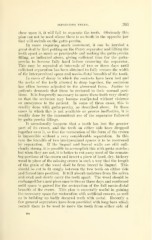Page 555 - My FlipBook
P. 555
SEPARATING TEETH. 263
chew upon it, it will fail to separate the tcetli. 01)vioiisly this
phm (^an not be used where there is no tooth in the opposite jaw
that will occlude on the gutta-percha.
In cases recfuiring- much inoveraent, it can be hurried a
great deal by first putting on the Perry separator and lifting the
teeth apart as much as practicable and making the gutta-percha
filling, as indicated above, giving sufficient time for the gutta-
))ercha to become fully hard before removing the separator.
This may be repeated at intervals of two or three days until
sufficient separation has been obtained to fully restore the width
of the interproximal space and mesio-distal breadth of the tooth.
In cases of decay in which the contacts have been lost and
the necks of the teeth allowed to drop together, the occlusion
has often become adjusted to the abnormal form. Justice to
patients demands that these be restored to their normal posi-
tions. It is frequently necessary to move these teeth very slowly
so that the occlusion may become readjusted without violence
or annoyance to the patient. In some of these cases, this is
readily done with gutta-percha, as described above. In those
cases in which this is not available or proves ineffective, it is
readily done by the intermittent use of the separator followed
by gutta-percha fillings.
It occasionally ha])pens that a tooth has lost the greater
part of its crown, and the teeth on either side have dropped
together over it, so that the restoration of the form of the crown
is impossible without a very considerable separation. In this
case the breadth of two interproximal spaces is to be recovered
by separation. If the lingual and buccal walls are still suffi-
ciently strong, it is possible to accomplish this with gutta-percha;
but when they are not, it is better to cut away most of the remain-
ing portions of the crown and insert a piece of hard, dry, hickory
wood in place of the missing crown in such a way that the length
of the grain of the wood shall be from buccal to lingual. This
should be cut to fit snugly between the two teeth on either side
and forced into position. It will absorb moisture from the saliva
and swell and slowly carry the teeth apart. The wood should be
exchanged for a new piece once in two or three days and continued
until space is gained for the restoration of the full mesio-distal
breadth of the crown. This plan is especially useful in gaining
the necessary space for restoration with artificial crowns, as well
as in building up badly decayed teeth with metal. Recently a
few general separators have been provided with long bars which
permit them to be used to move the teeth from either side of


